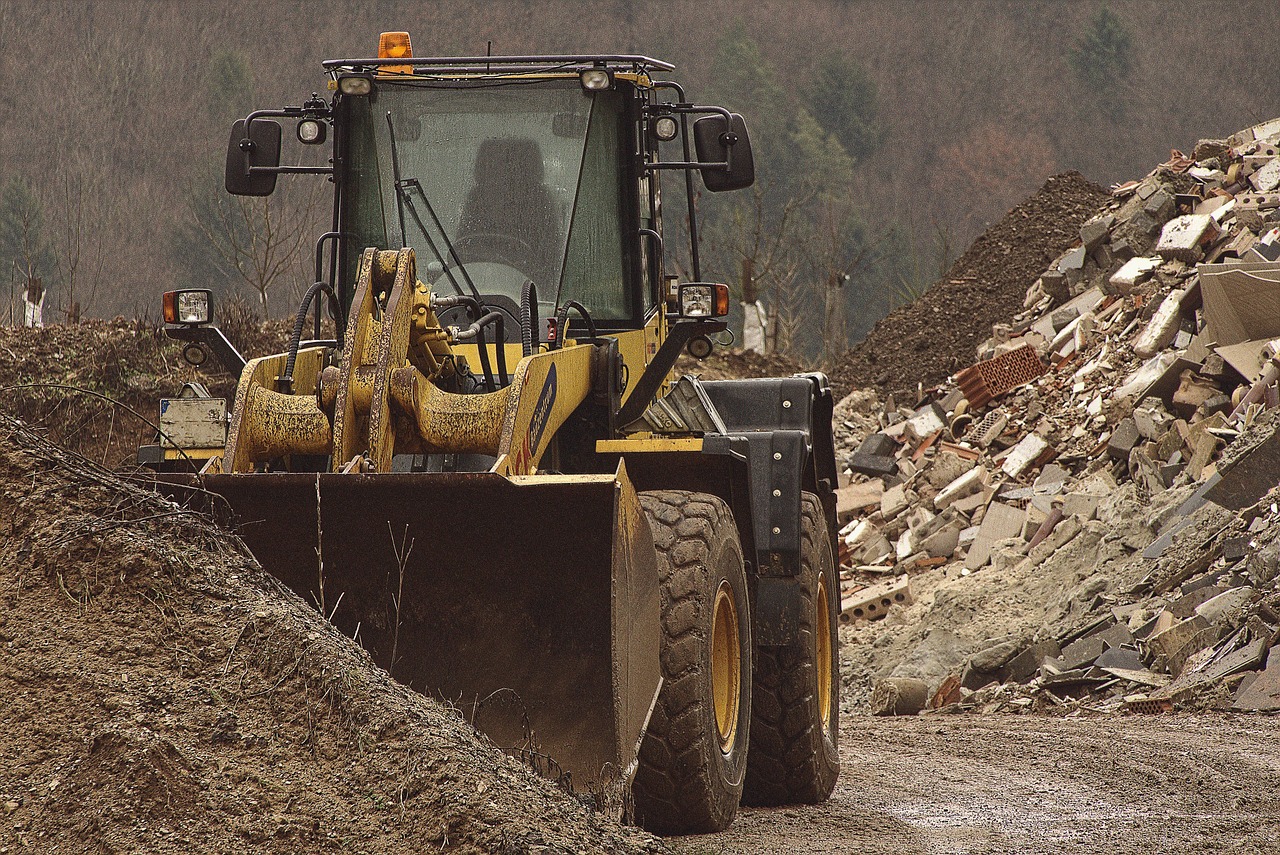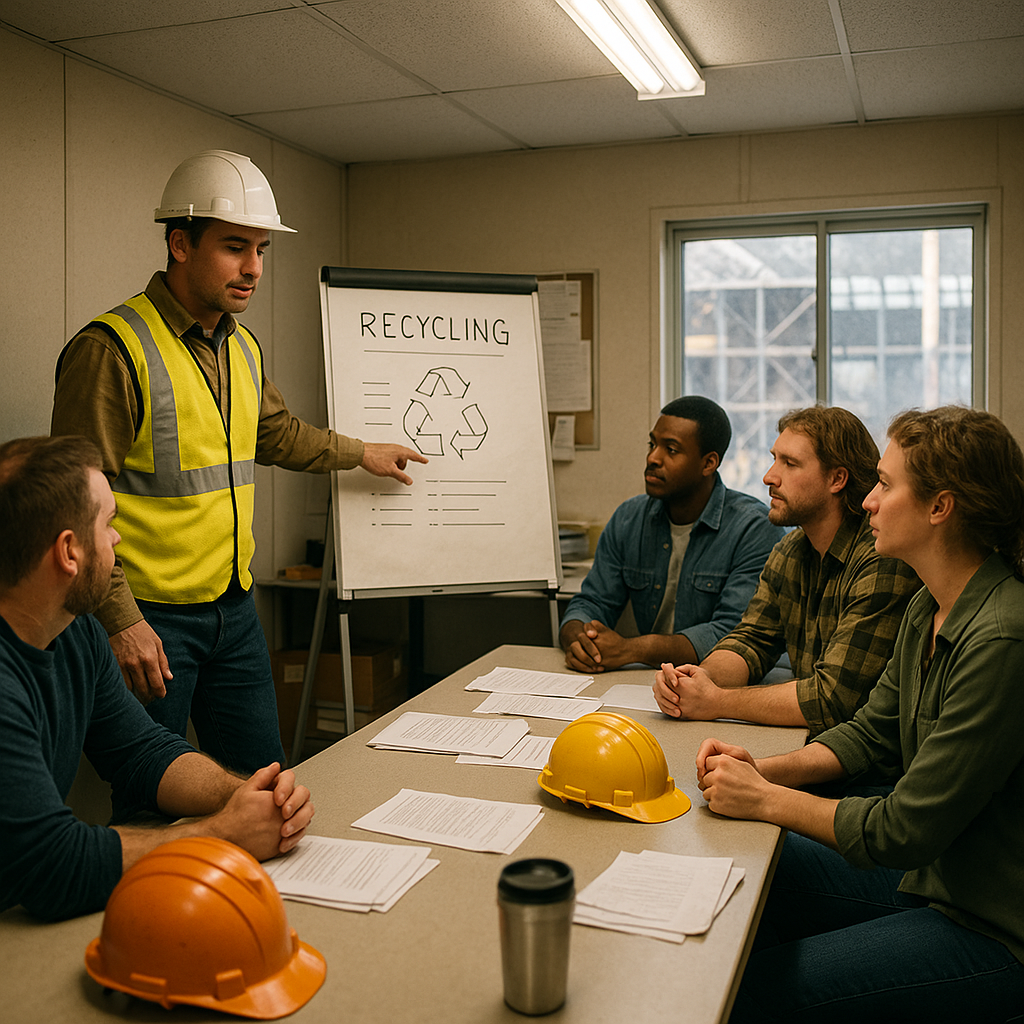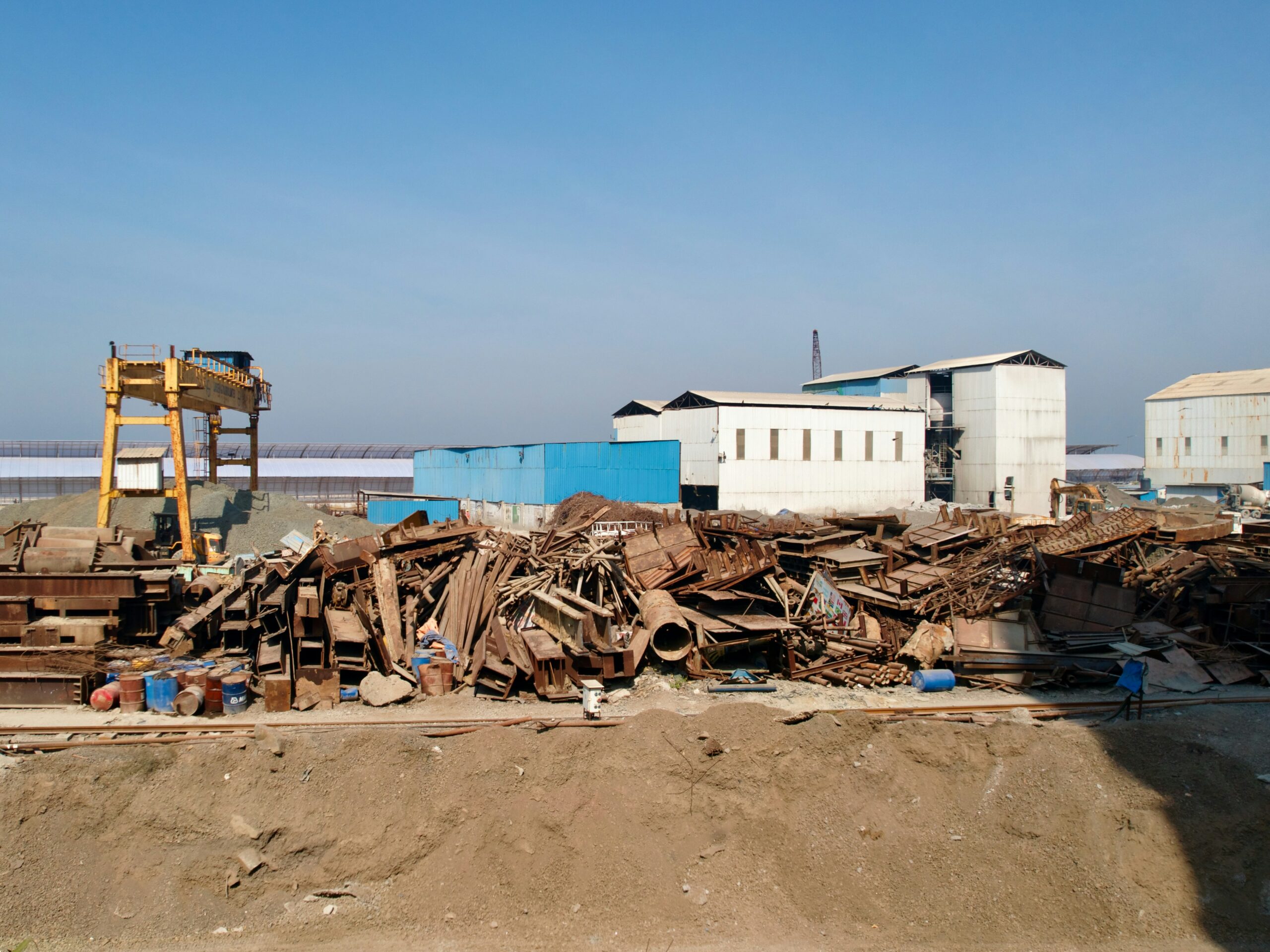5901 Botham Jean Blvd, Dallas, TX 75215
What Are Construction Recycling Awareness Campaigns?
May 22, 2025The construction industry generates millions of tons of waste annually, making it one of the largest contributors to global waste. Construction recycling awareness campaigns are strategic initiatives designed to address this challenge by promoting the importance of recycling materials across building projects.
These campaigns serve as catalysts for change in the construction sector. They focus on informing stakeholders about the benefits of recycling materials like concrete, wood, steel, and asphalt. Through targeted information sharing, they aim to shift industry perceptions about recycled materials and their applications.
At their core, these campaigns target municipalities, contractors, project managers, and sustainability officers. They highlight how recycling reduces environmental impact and offers economic benefits through decreased disposal costs and potential new revenue streams from salvaged materials.
Why are Construction Recycling Awareness Campaigns Important?

Construction recycling awareness campaigns drive sustainable practices across the building industry. The construction sector generates about 30% of all waste worldwide, making targeted education and promotion of recycling solutions essential.
These campaigns address the environmental challenges posed by construction waste. When materials end up in landfills, they contribute to soil and water contamination and occupy valuable land space. By promoting recycling, these initiatives help divert significant waste from landfills, reducing the environmental footprint of construction activities.
Recycling awareness campaigns also help lower greenhouse gas emissions. Producing new construction materials requires extensive energy and resources. Recycling materials like concrete, wood, and metals reduces the need for virgin resources, minimizing carbon emissions from production and transportation.
These campaigns promote circular economy principles within the industry. Instead of the traditional take-make-dispose model, contractors learn to view materials as resources for continuous reuse. This perspective creates economic opportunities through material recovery and fosters sustainable resource management.
From a business perspective, these initiatives highlight the economic benefits of recycling construction waste. Companies can achieve cost savings through reduced disposal fees, lower material expenses, and streamlined waste management. For example, recycling concrete can save contractors $8–$12 per ton compared to landfill disposal.
Recycling campaigns also serve a regulatory function. As governments enforce stricter regulations on construction waste disposal, these educational efforts help companies understand compliance requirements and avoid fines or legal issues.
By engaging stakeholders across the construction value chain, from architects and developers to contractors and suppliers, these campaigns create momentum for industry-wide recycling practices. This collaborative approach is crucial for creating lasting change in a sector traditionally generating significant waste.
Importantly, recycling awareness campaigns in construction contribute to broader sustainability goals. They align with global initiatives like the United Nations’ Sustainable Development Goals by promoting responsible consumption, climate action, and sustainable communities, positioning the construction industry as part of the solution to environmental challenges.
| Benefit Type | Details |
|---|---|
| Environmental Benefits | Reduces landfill waste, conserves natural resources, lowers greenhouse gas emissions |
| Economic Benefits | Reduces disposal costs, generates revenue from recycled materials, enhances project efficiency |
| Social Benefits | Creates jobs, improves public health, promotes sustainable development |
How to Implement Effective Construction Recycling Awareness Campaigns?

Implementing effective recycling awareness campaigns in construction projects requires strategic planning and a multi-channel approach. Successful campaigns educate workers while fostering a culture of sustainability throughout the construction ecosystem. Recycling awareness is not just about putting up signs; it demands a comprehensive approach that addresses all stakeholders involved in the construction process.
Worker Training Programs
Construction workers are the frontline of any recycling initiative. Well-designed training programs help them understand why recycling matters and how to do it properly on site. These programs should include hands-on demonstrations that show proper sorting techniques for different materials commonly found on construction sites.
Training sessions are most effective when they are regular and reinforced with real-world applications. Schedule monthly refresher courses that highlight recycling successes and address common challenges. For maximum impact, integrate recycling protocols into safety meetings so they become part of standard operating procedures.
Consider designating recycling champions on each construction team. These individuals can help monitor compliance, answer questions, and recognize good recycling practices among their peers. Workers who understand the real environmental impact of construction waste are more likely to actively participate in recycling efforts.
Developing Clear Waste Management Plans
Every construction project needs a detailed waste management plan that clearly outlines recycling procedures. These plans should identify all recyclable materials specific to the project and establish collection points throughout the site. They must also assign responsibilities for monitoring and maintaining recycling stations.
Set measurable goals for waste diversion and track progress regularly. Share these metrics with all team members to foster accountability and motivation. Good waste management plans include contingency procedures for handling unexpected waste streams that may emerge during different construction phases.
Document successful recycling practices and incorporate them into future project plans. This creates a continuous improvement cycle that enhances recycling effectiveness over time. Remember that waste management plans should evolve as projects progress and as new recycling opportunities arise.
Engaging Suppliers and Manufacturers
Effective recycling campaigns extend beyond the construction site to include material suppliers and manufacturers. Collaborate with these partners to identify recyclable packaging and products with recycled content. Request that suppliers minimize unnecessary packaging when delivering materials to your sites.
Establish take-back programs with suppliers for materials like unused paint, packaging, and other recoverable items. This creates a closed-loop system that reduces waste sent to landfills. Host supplier workshops to discuss sustainable materials and recycling innovations that benefit both parties.
Consider developing preferred supplier lists that prioritize companies with strong environmental commitments. This encourages more suppliers to improve their sustainability practices. Working closely with manufacturers can also help identify construction methods that generate less waste in the first place.
Community Engagement Strategies
Construction recycling campaigns gain strength when they connect with the surrounding community. Host open houses that showcase your recycling efforts to neighbors and local businesses. Participate in community events where you can highlight the environmental benefits of construction recycling.
Partner with local schools for educational opportunities about construction recycling. This builds positive community relationships while educating the next generation about sustainability. Consider donating recovered materials to community projects when appropriate, demonstrating your commitment to local environmental stewardship.
Create opportunities for community feedback about your recycling initiatives. This develops goodwill and might generate innovative ideas to improve your programs. Strong community connections help position your construction company as an environmental leader in the areas where you work.
Effective Communication Channels
The success of recycling awareness campaigns depends on clear, consistent messaging across multiple platforms. Use a variety of communication tools to reach different audiences with tailored recycling information. Simple, direct language works best when explaining recycling procedures and benefits.
- On-site signage with visual instructions for proper sorting
- Digital communications including email updates and project portals
- Social media campaigns highlighting recycling successes
- Project newsletters featuring recycling tips and achievements
- Posters in high-traffic areas showing accepted recyclables
- Branded recycling stations that stand out on construction sites
Messages should explain both how to recycle and why it matters. This dual approach increases compliance by helping workers understand the purpose behind recycling requests. Regular communication keeps recycling top-of-mind throughout the project lifecycle.
Creating Recognition and Incentive Programs
Recognizing and rewarding good recycling practices reinforces desired behaviors. Implement award programs that celebrate teams with the best recycling performance. Consider friendly competitions between different work crews to boost recycling participation rates.
Public recognition through company newsletters or site meetings acknowledges those who make extra efforts to recycle properly. Even simple recognitions like certificates or small prizes can motivate continued participation in recycling programs. Making recycling success visible helps create social norms that support sustainable practices.
Track and publicize the positive impacts of your recycling efforts. When workers see metrics about diverted waste or resources saved, it reinforces the value of their participation. This creates a sense of accomplishment and purpose that motivates continued engagement with recycling initiatives.
Monitoring and Improving Campaign Performance
Regular assessment of recycling campaign effectiveness allows for continuous improvement. Conduct waste audits to identify which materials are being recycled correctly and which need more attention. Use this data to refine training programs and communication strategies.
Solicit feedback from workers about barriers to recycling. Their insights often reveal simple fixes that can dramatically improve participation. Adjust your approach based on what is working well and what needs enhancement.
Document successful strategies for future projects. Building a knowledge base of effective practices creates organizational learning that improves recycling outcomes over time. Remain flexible and willing to try new approaches when current methods are not achieving desired results.
| Step | Task | Responsible Party | Timeframe |
| 1 | Create Waste Management Plan | Project Manager | 1 month before project start |
| 2 | Conduct Waste Audit | Recycling Coordinator | 2 weeks before project start |
| 3 | Set Up On-Site Sorting Facilities | Site Supervisor | 1 week before project start |
| 4 | Engage and Train Workers | Training Officer | During project execution |
| 5 | Monitor and Track Progress | Recycling Coordinator | Ongoing |
| 6 | Adjust Strategies as Needed | Project Manager | Monthly reviews |
Implementing effective recycling awareness campaigns requires commitment at all levels of a construction project. With proper planning, clear communication, and ongoing support, these campaigns can significantly reduce waste while creating a culture of environmental responsibility. The investment in awareness building pays dividends through reduced disposal costs, improved company reputation, and meaningful environmental benefits.
What are the Challenges in Construction Recycling Awareness?

The construction industry faces several significant barriers to recycling awareness. Industry fragmentation is a major obstacle. With numerous contractors, subcontractors, and stakeholders involved, establishing consistent recycling protocols is challenging, leading to inconsistent practices across sites and regions.
Material quality concerns are another challenge. Many professionals doubt the performance and reliability of recycled materials due to misconceptions about durability. Without proper education on testing standards, stakeholders often default to virgin materials.
Long-standing practices create resistance to change. The sector operates on tight schedules and established supply chains. New recycling protocols may initially slow projects or disrupt workflows, especially where landfill disposal is inexpensive.
Limited stakeholder collaboration compounds these challenges. Different parties—from architects to waste handlers—often work in isolation, preventing cohesive recycling strategies. When teams don’t coordinate, recyclable materials often end up in landfills.
Inadequate infrastructure is another limitation. In many regions, recycling facilities for construction materials are scarce, forcing contractors to transport waste long distances, increasing costs and emissions. The lack of convenient options often makes landfill disposal the default.
Cost perceptions also hinder recycling. Initial setup costs for on-site sorting systems can seem prohibitive. Many contractors focus on immediate expenses, overlooking potential savings from reduced disposal fees and material reuse.
Turning these challenges into opportunities requires innovation. Technology solutions like mobile recycling units can process materials on-site, reducing costs and improving sustainability.
Education initiatives are promising. Training programs can dispel misconceptions about recycled materials and teach sorting techniques. Case studies of successful projects illustrate practical benefits and cost savings.
Regulatory incentives can drive change. Tax benefits for recycling and increased landfill fees motivate sustainable practices. Some jurisdictions require waste management plans before issuing permits, standardizing recycling expectations.
Collaborative platforms connecting stakeholders can overcome communication barriers. Digital tools tracking waste and recycling rates provide data for improvement, enabling coordination among architects and waste handlers.
By viewing these challenges as opportunities for innovation, the construction industry can transform its relationship with waste, progressing toward a more sustainable and efficient sector.
Conclusion: Building a Cleaner Future, One Project at a Time
Construction recycling awareness campaigns are more than educational tools—they’re a blueprint for a more sustainable industry. By embracing recycling practices, stakeholders reduce environmental harm, unlock economic value, and align with global sustainability goals. Whether it’s through better training, smarter waste management plans, or stronger supplier partnerships, the path to progress starts with informed action.
If you’re ready to take the next step toward smarter, greener construction practices, contact Okon Recycling at 214-717-4083. Our team is here to support your recycling efforts and help your projects leave a lasting impact—for your business and the planet.
